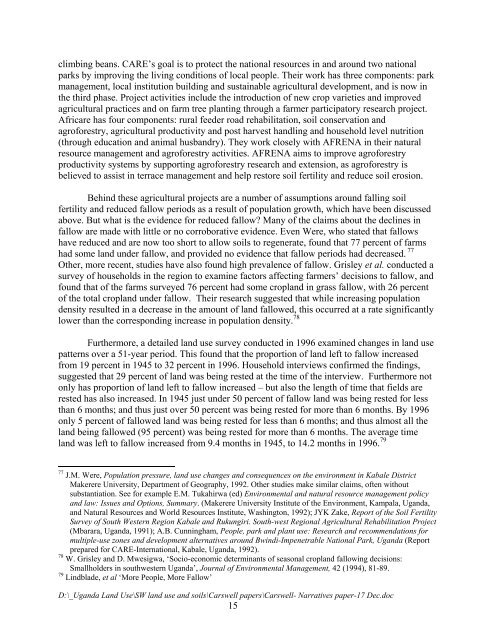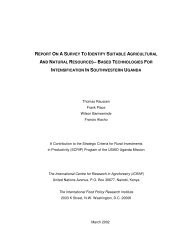Continuities in environmental narratives, Kabale, Uganda ... - Foodnet
Continuities in environmental narratives, Kabale, Uganda ... - Foodnet
Continuities in environmental narratives, Kabale, Uganda ... - Foodnet
You also want an ePaper? Increase the reach of your titles
YUMPU automatically turns print PDFs into web optimized ePapers that Google loves.
climb<strong>in</strong>g beans. CARE’s goal is to protect the national resources <strong>in</strong> and around two national<br />
parks by improv<strong>in</strong>g the liv<strong>in</strong>g conditions of local people. Their work has three components: park<br />
management, local <strong>in</strong>stitution build<strong>in</strong>g and susta<strong>in</strong>able agricultural development, and is now <strong>in</strong><br />
the third phase. Project activities <strong>in</strong>clude the <strong>in</strong>troduction of new crop varieties and improved<br />
agricultural practices and on farm tree plant<strong>in</strong>g through a farmer participatory research project.<br />
Africare has four components: rural feeder road rehabilitation, soil conservation and<br />
agroforestry, agricultural productivity and post harvest handl<strong>in</strong>g and household level nutrition<br />
(through education and animal husbandry). They work closely with AFRENA <strong>in</strong> their natural<br />
resource management and agroforestry activities. AFRENA aims to improve agroforestry<br />
productivity systems by support<strong>in</strong>g agroforestry research and extension, as agroforestry is<br />
believed to assist <strong>in</strong> terrace management and help restore soil fertility and reduce soil erosion.<br />
Beh<strong>in</strong>d these agricultural projects are a number of assumptions around fall<strong>in</strong>g soil<br />
fertility and reduced fallow periods as a result of population growth, which have been discussed<br />
above. But what is the evidence for reduced fallow? Many of the claims about the decl<strong>in</strong>es <strong>in</strong><br />
fallow are made with little or no corroborative evidence. Even Were, who stated that fallows<br />
have reduced and are now too short to allow soils to regenerate, found that 77 percent of farms<br />
had some land under fallow, and provided no evidence that fallow periods had decreased. 77<br />
Other, more recent, studies have also found high prevalence of fallow. Grisley et al. conducted a<br />
survey of households <strong>in</strong> the region to exam<strong>in</strong>e factors affect<strong>in</strong>g farmers’ decisions to fallow, and<br />
found that of the farms surveyed 76 percent had some cropland <strong>in</strong> grass fallow, with 26 percent<br />
of the total cropland under fallow. Their research suggested that while <strong>in</strong>creas<strong>in</strong>g population<br />
density resulted <strong>in</strong> a decrease <strong>in</strong> the amount of land fallowed, this occurred at a rate significantly<br />
lower than the correspond<strong>in</strong>g <strong>in</strong>crease <strong>in</strong> population density. 78<br />
Furthermore, a detailed land use survey conducted <strong>in</strong> 1996 exam<strong>in</strong>ed changes <strong>in</strong> land use<br />
patterns over a 51-year period. This found that the proportion of land left to fallow <strong>in</strong>creased<br />
from 19 percent <strong>in</strong> 1945 to 32 percent <strong>in</strong> 1996. Household <strong>in</strong>terviews confirmed the f<strong>in</strong>d<strong>in</strong>gs,<br />
suggested that 29 percent of land was be<strong>in</strong>g rested at the time of the <strong>in</strong>terview. Furthermore not<br />
only has proportion of land left to fallow <strong>in</strong>creased – but also the length of time that fields are<br />
rested has also <strong>in</strong>creased. In 1945 just under 50 percent of fallow land was be<strong>in</strong>g rested for less<br />
than 6 months; and thus just over 50 percent was be<strong>in</strong>g rested for more than 6 months. By 1996<br />
only 5 percent of fallowed land was be<strong>in</strong>g rested for less than 6 months; and thus almost all the<br />
land be<strong>in</strong>g fallowed (95 percent) was be<strong>in</strong>g rested for more than 6 months. The average time<br />
land was left to fallow <strong>in</strong>creased from 9.4 months <strong>in</strong> 1945, to 14.2 months <strong>in</strong> 1996. 79<br />
77 J.M. Were, Population pressure, land use changes and consequences on the environment <strong>in</strong> <strong>Kabale</strong> District<br />
Makerere University, Department of Geography, 1992. Other studies make similar claims, often without<br />
substantiation. See for example E.M. Tukahirwa (ed) Environmental and natural resource management policy<br />
and law: Issues and Options, Summary. (Makerere University Institute of the Environment, Kampala, <strong>Uganda</strong>,<br />
and Natural Resources and World Resources Institute, Wash<strong>in</strong>gton, 1992); JYK Zake, Report of the Soil Fertility<br />
Survey of South Western Region <strong>Kabale</strong> and Rukungiri. South-west Regional Agricultural Rehabilitation Project<br />
(Mbarara, <strong>Uganda</strong>, 1991); A.B. Cunn<strong>in</strong>gham, People, park and plant use: Research and recommendations for<br />
multiple-use zones and development alternatives around Bw<strong>in</strong>di-Impenetrable National Park, <strong>Uganda</strong> (Report<br />
prepared for CARE-International, <strong>Kabale</strong>, <strong>Uganda</strong>, 1992).<br />
78 W. Grisley and D. Mwesigwa, ‘Socio-economic determ<strong>in</strong>ants of seasonal cropland fallow<strong>in</strong>g decisions:<br />
Smallholders <strong>in</strong> southwestern <strong>Uganda</strong>’, Journal of Environmental Management, 42 (1994), 81-89.<br />
79 L<strong>in</strong>dblade, et al ‘More People, More Fallow’<br />
D:\_<strong>Uganda</strong> Land Use\SW land use and soils\Carswell papers\Carswell- Narratives paper-17 Dec.doc<br />
15
















